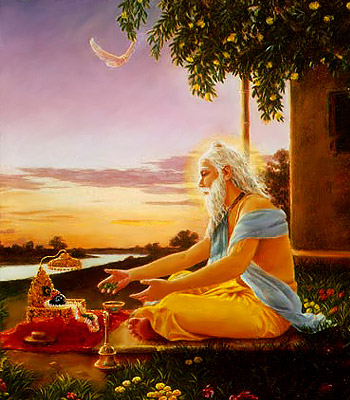 Advaita Acharya is the foremost of all the Vaishnavas who resided at Navadwip. He is the most well known preceptor in all fields which includes knowledge, renunciation and devotion. Advaita Acharya (1434-1539) was known as Kamalaksha Bhattacharya initially. He was born at Navagrama Laur village which is presently located in Sylhet District of Bangladesh in 1434. He spent most of his life in the town of Shantipur with his family. He had six sons. Acyutananda, Krsna Misra, Gopala dasa, Balarama, Svarupa, and Jagadisa were his six sons. He taught the philosophy of Bhagavad Gita and Bhagavata Purana and promotes Bhakti Yoga.
Advaita Acharya is the foremost of all the Vaishnavas who resided at Navadwip. He is the most well known preceptor in all fields which includes knowledge, renunciation and devotion. Advaita Acharya (1434-1539) was known as Kamalaksha Bhattacharya initially. He was born at Navagrama Laur village which is presently located in Sylhet District of Bangladesh in 1434. He spent most of his life in the town of Shantipur with his family. He had six sons. Acyutananda, Krsna Misra, Gopala dasa, Balarama, Svarupa, and Jagadisa were his six sons. He taught the philosophy of Bhagavad Gita and Bhagavata Purana and promotes Bhakti Yoga.
Life of Advaita Acharya is narrated in several biographical works which include the Balyalilasutra of Krishnadasa and the Advaitasutrakadacha of Krishnadasa, the Advaitamangala of Haricharanadasa, the Advaitaprakasha of Ishana Nagara and the Advaitavilasa of Naraharidasa in Bengali.
Advaita Acharya was not satisfied with the materialistic goals that pursued by society. This led to a non adaptive and an unhappy society and concluded that the only solution was offering prayers. It is believed that he prayed for several months and worshipped Lord in the form of his Shaligram Shila with sacred Tulsi leaves and water of River Ganga.
He was a close friend of both Chaitanya and Nityananda and helped them in spreading the Hare Krishna mantra. It is believed that he was a combined incarnation of both Lord Vishnu and Lord Shiva within the Gaudiya tradition.
This article is a stub. You can enrich by adding more information to it. Send your Write Up to content@indianetzone.com




















